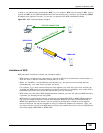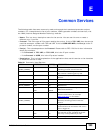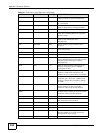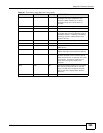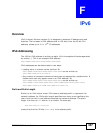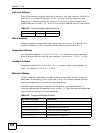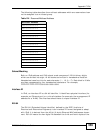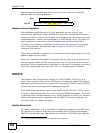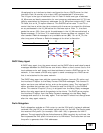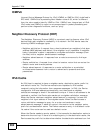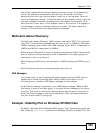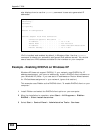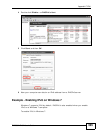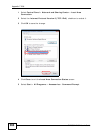
Appendix F IPv6
EMG5324-D10A User’s Guide
359
The following table describes the multicast addresses which are reserved and can
not be assigned to a multicast group.
Subnet Masking
Both an IPv6 address and IPv6 subnet mask compose of 128-bit binary digits,
which are divided into eight 16-bit blocks and written in hexadecimal notation.
Hexadecimal uses four bits for each character (1 ~ 10, A ~ F). Each block’s 16 bits
are then represented by four hexadecimal characters. For example,
FFFF:FFFF:FFFF:FFFF:FC00:0000:0000:0000.
Interface ID
In IPv6, an interface ID is a 64-bit identifier. It identifies a physical interface (for
example, an Ethernet port) or a virtual interface (for example, the management IP
address for a VLAN). One interface should have a unique interface ID.
EUI-64
The EUI-64 (Extended Unique Identifier) defined by the IEEE (Institute of
Electrical and Electronics Engineers) is an interface ID format designed to adapt
with IPv6. It is derived from the 48-bit (6-byte) Ethernet MAC address as shown
next. EUI-64 inserts the hex digits fffe between the third and fourth bytes of the
Table 124 Reserved Multicast Address
MULTICAST ADDRESS
FF00:0:0:0:0:0:0:0
FF01:0:0:0:0:0:0:0
FF02:0:0:0:0:0:0:0
FF03:0:0:0:0:0:0:0
FF04:0:0:0:0:0:0:0
FF05:0:0:0:0:0:0:0
FF06:0:0:0:0:0:0:0
FF07:0:0:0:0:0:0:0
FF08:0:0:0:0:0:0:0
FF09:0:0:0:0:0:0:0
FF0A:0:0:0:0:0:0:0
FF0B:0:0:0:0:0:0:0
FF0C:0:0:0:0:0:0:0
FF0D:0:0:0:0:0:0:0
FF0E:0:0:0:0:0:0:0
FF0F:0:0:0:0:0:0:0



